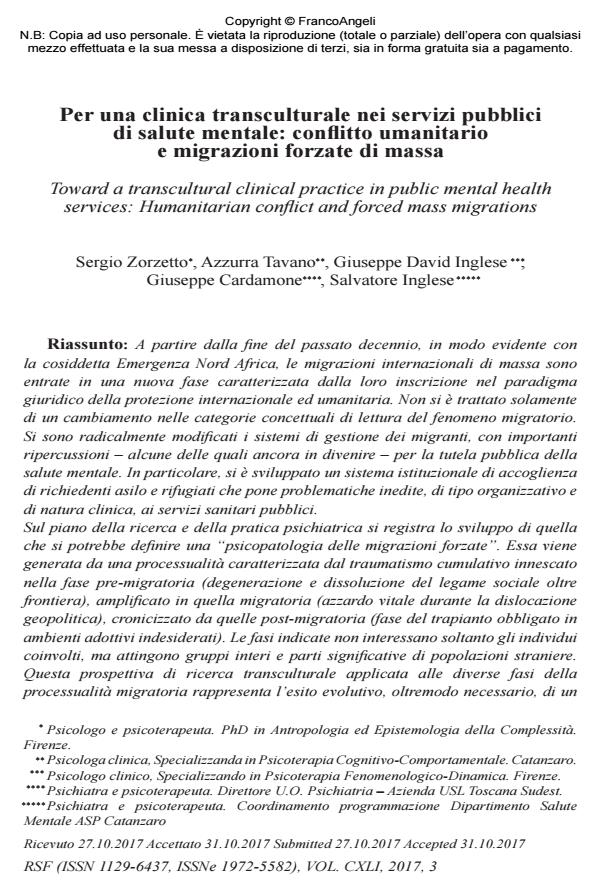Toward a transcultural clinical practice in public mental health services: Humanitarian conflict and forced mass migrations
Journal title RIVISTA SPERIMENTALE DI FRENIATRIA
Author/s Sergio Zorzetto, Azzurra Tavano, Giuseppe David Inglese, Giuseppe Cardamone, Salvatore Inglese
Publishing Year 2017 Issue 2017/3
Language Italian Pages 28 P. 23-50 File size 775 KB
DOI 10.3280/RSF2017-003003
DOI is like a bar code for intellectual property: to have more infomation
click here
Below, you can see the article first page
If you want to buy this article in PDF format, you can do it, following the instructions to buy download credits

FrancoAngeli is member of Publishers International Linking Association, Inc (PILA), a not-for-profit association which run the CrossRef service enabling links to and from online scholarly content.
Since the end of the past decade, particularly during the North African humanitarian Emergency, international mass migrations entered the new legal framework of international human rights protection. This novel approach not only modified the conceptual interpretation of migration, but also the management of migration, producing major repercussions - some of which are still underway - on public mental health care. Asylum seekers and refugees pose nowadays unprecedented organizational and clinical issues to the public health system. Researchers and clinicians are currently observing the development of a "psychopathology of forced migration". This phenomenon is generated by a cumulative trauma exposure starting from the pre-migration phase (disintegration and breakdown of social links in the country of origin), then amplified during the migratory phase (life-threatening situations) and becoming chronic during the post-migratory phase (forced settlement in an imposed environment). These traumas do not only affect single individuals, but also whole groups, i.e. significant parts of migrant populations. This perspective of trans-cultural research, applied to the different phases of migration, is in line with the long-established trend of studies on the "psychopathology of migration". Public mental health services should take into account the complexity of this phenomenon and build stronger links with the reception facilities for asylum seekers and refugees, in order to reduce the psychopathological consequences of migration.
Keywords: Ethnopsychiatry, psychopathology, migration, asylum seekers, refugees, borders.
Sergio Zorzetto, Azzurra Tavano, Giuseppe David Inglese, Giuseppe Cardamone, Salvatore Inglese, Per una clinica transculturale nei servizi pubblici di salute mentale: conflitto umanitario e migrazioni forzate di massa in "RIVISTA SPERIMENTALE DI FRENIATRIA" 3/2017, pp 23-50, DOI: 10.3280/RSF2017-003003